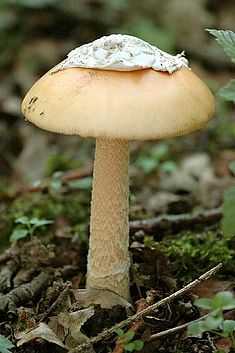Amanita citrina
| ||||||||||||||||||||||||||||||||||||||||||||
Known as the false death cap, or Citron Amanita, Amanita citrina (previously also known as Amanita mappa), is a basidiomycotic mushroom, one of many in the genus Amanita. It grows in silicate soil in the summer and autumn months. It bears a pale yellow or sometimes white cap, with white stem, ring and volva. Though it is not highly poisonous, its similarity to the lethal death cap (Amanita phalloides) precludes its use in cooking.
Description

This mushroom has a fleshy pale yellow, or sometimes white, cap from 4–10 cm (1.5–4 in) across, covered in irregular patches. The gills and flesh are white. There is a large volva at the base of the 6–8 cm (2.5–3 in) tall stem, which has a clear ring. This mushroom is not eaten, having a smell of rapeseed or potato. It is often confused with the related death cap mushroom (Amanita phalloides), hence the name.[1]
Distribution and habitat
The false death cap is found in deciduous and coniferous woodlands in Autumn in Europe.[1] It is also found in North American oak and pine forests.
Toxicity
Scientific tests in the University of Cambridge have shown that this mushroom contains the alpha-amanitin toxin. However, the amounts of this toxin were found to be very small and would not cause any adverse effects unless the mushroom was ingested in very large amounts. The biggest danger with this species is its marked similarity to the death cap, which is reason enough to avoid it, even though it is edible.
Gallery
-

A closer view of an emergent specimen.
-

Amanita citrina from Commanster, Belgium.
-

Amanita citrina at the 12-th countrywide mushroom exhibition 2008, Žofín, Prague, Czech Republic.
-

A. citrina in Ukraine (Co-ordinates:49°19′20.03″N 28°33′29.20″E / 49.3222306°N 28.5581111°E).
See also
References
| Wikimedia Commons has media related to Amanita citrina. |
External links
- Amanita citrina on Mushroomexpert.com

